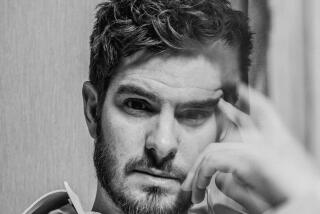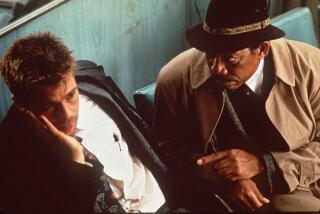Mind over grisly matter
- Share via
A dozen years ago, with the disturbing, graphic serial killer procedural “Seven,” David Fincher staked his claim as one of the more intriguing young American directors. Since then, his films -- “The Game,” “Fight Club” and “Panic Room” -- have helped cement his reputation as a visually sophisticated stylist while dividing critics on their substance.
So it comes as something of a surprise that Fincher’s latest, “Zodiac,” is primarily a complex character study, despite the film’s grim and gruesome subject matter. It’s a role reversal of sorts for a director who normally emphasizes the brutal tension in his movies.
Written by James Vanderbilt based on Robert Graysmith’s nonfiction book, the intelligent thriller delves into the compulsive effect that the Zodiac killer case had on the Bay Area police detectives and journalists investigating it.
Overlong and lacking dramatic focus, the film nevertheless captures the dark allure that the unsolved crimes had on the region over a 22-year period. Taunting police with threatening letters and ciphers sent to newspapers, the Zodiac terrorized Northern California by claiming responsibility for 13 murders. Combing through 2,500 suspects, the multi-jurisdictional manhunt is fascinating in its minutia and the ways the men respond to the pressures of pursuing a madman.
The Zodiac inspired at least half a dozen earlier movies -- notably “Dirty Harry” -- and serial killers in general tend to provoke filmmakers to action. Often, however, their stories tend to become jumping-off points for creating horror films. Vanderbilt and Fincher, on the other hand, are far more interested in the psychological elements, particularly the toll that reaches beyond the victims, although the story is sometimes overwhelmed by the vast amount of detail they shoehorn into the film.
The filmmakers enhanced their characters mightily by assembling a top-drawer cast. Headed by Jake Gyllenhaal as Graysmith, the San Francisco Chronicle political cartoonist who would eventually become the primary author on the subject, Mark Ruffalo as lead San Francisco Police Department Inspector Dave Toschi and Robert Downey Jr. as Chronicle crime reporter Paul Avery, the actors get at the heart of what drove these men and the price they paid for their commitment.
There are really two movies going on, the more pro forma detective story focusing on the police and a slightly goofy yarn involving the journalists.
As Toschi -- the alleged inspiration for the characters played by Steve McQueen in “Bullitt,” Clint Eastwood in “Dirty Harry” and Michael Douglas in the television series “The Streets of San Francisco” -- Ruffalo has one of his best roles since his breakout performance seven years ago in “You Can Count on Me.” Toschi is cocky, witty and assertive, and Ruffalo expresses the weariness that comes from spending so many years on one case. Anthony Edwards plays his partner, Inspector Bill Armstrong, a man so worn down by the process that he eventually puts in for a transfer from homicide.
In contrast to the cops is Gyllenhaal’s Graysmith, whose enthusiasm for the case grows with time. Initially intrigued by the Zodiac’s puzzles, Graysmith eventually becomes so obsessed that he’s practically the only one still sifting through the evidence. Downey is electric as the glib, debauched Avery, whose bravado annoys the police and helps to reel in Graysmith.
Among the rest of the large cast, Brian Cox is a standout as attorney Melvin Belli. Coincidentally, Philip Baker Hall, who plays a handwriting specialist, also starred in an independently made 2005 film, “The Zodiac,” which told the story from the perspective of a Vallejo detective played by Justin Chambers of “Grey’s Anatomy.”
Early on, Fincher re-creates the murders effectively enough in large set pieces, but they are oddly lacking in tension. Vanderbilt peppers the script with humor, but the suspense does not really kick in until it focuses on Graysmith as the protagonist in the film’s second half.
The final 45 minutes, when the film’s primary characters come into harm’s way, are by far the most chilling sequences. It could be that we simply don’t have enough invested in the other characters to be frightened for them or it might be something more disturbing. Serial killers were once the most frightening criminals we could imagine, but now we live in a time when killers walk into schools and shopping malls with automatic weapons and the possibility exists that a suicide bomber might strike, claiming many victims. Could it be that a killer randomly picking off individuals and couples simply isn’t as scary as it used to be?
“Zodiac.” MPAA rating: R for some strong killings, language, drug material and brief sexual images. Running time: 2 hour, 38 minutes. In general release.
More to Read
Only good movies
Get the Indie Focus newsletter, Mark Olsen's weekly guide to the world of cinema.
You may occasionally receive promotional content from the Los Angeles Times.











